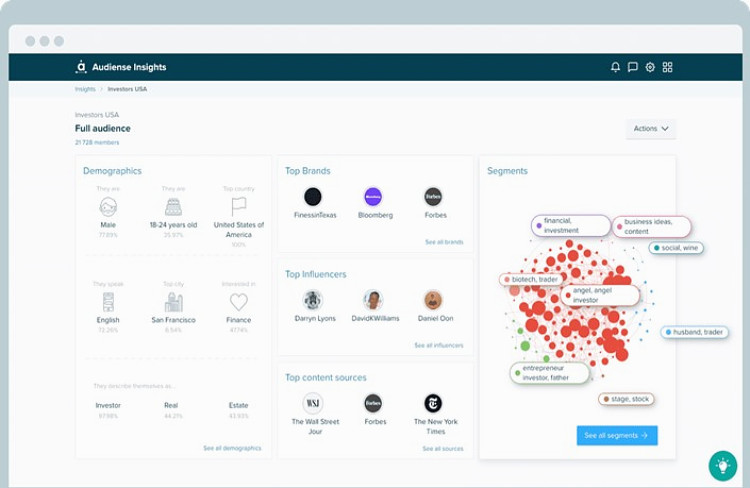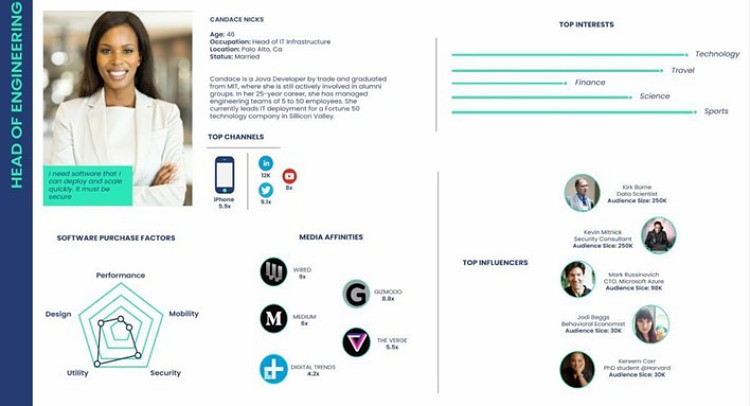Audience analysis is the assessment and identification of interests, attitudes, preferences, behaviors, demographics, needs, and other data points of a particular group. In a business setting, audience analysis allows businesses to understand current and potential customers.
Proper audience analysis generates insightful data that can benefit your business in various ways:
- A better understanding of your audience can improve engagement rates and generate more sales.
- Audience analysis also helps you cultivate customer relations.
- Knowing your target audience and what it cares about makes it easier to create relevant content.
- It even allows you to refine your business model to deliver an optimal customer experience.
Here's how to conduct audience analysis effectively.
1. Identify your target audience
The first stage of audience analysis involves defining your target audience. One way of doing that is through market research. You can conduct surveys, interviews, focus groups, and other types of research to define your ideal customer better.
Alongside market research, you can also analyze your current customer database. Analyze the people buying your products and identify commonalities, trends, and behaviors you can tap into.
Advanced audience intelligence tools can help speed up the process of identifying your target audience. Such tools can provide rich real-time insights into demographics and audience personality traits, interests, online habits, and preferred influencers and brands.

The data you gather will provide a deeper understanding of your audience. Armed with that knowledge, you can put insight into action to enhance your business and marketing strategies.
For example, by examining the personality traits of your target audience, you may notice that your customers are goal-oriented. Use that insight to develop a campaign that aligns with that trait and persuades them into action. Consider messaging around achieving or furthering their goals, or make it clear that purchasing a product or service from you will fulfill a goal in a meaningful way. Messaging tailored to your audience's personality or behaviors is likely to be more effective than a generalized copy line.
Another strategy is to use competitor analysis to define your target audience. Research your competitors and find out whom they are targeting. An excellent place to start is reviewing what social media platforms they use and whom they engage with.
2. Segment your audience
Once you have defined your audience, you need to segment it into smaller groups. You should create audience groups by identifying shared attributes or commonalities. Audience segments need to be relevant, measurable, and accessible for them to be truly effective in your campaigns.
For example, a SaaS company could segment its audience based on company size. It may have three segments in such a scenario: small, medium, and large companies. The company can then interact with each segment and target it with specific types of content tailored to its needs and goals.
Audience segmentation based on needs and goals requires additional research. You may include a questionnaire in your onboarding process, or use an audience intelligence tool to identify client needs.
Many companies have successfully used this approach. Insurance company MAPFRE, for example, used audience segmentation to run more targeted marketing campaigns. The company identified topics of interest per segment and created content based on them.
The campaign generated positive results within three months. The personalized content had a higher engagement rate than nonpersonalized posts. The engagement rate for the best-performing personalized content was 2.65%, compared with 2.27% for the best-performing nonpersonalized post. That led to a lower cost per click (CPC) and cost per engagement (CPE).
3. Identify priority characteristics
When your audience segments are in place, consider how to boost engagement. You could review the communication and advertising channels you are using. Are digital channels such as social media, PPC, and SEO enough, or do you need to add print and television ads as well?
What about interests? Are there any shared interests within your audience segments that you could exploit to boost the performance of your campaign?
Acting on those insights can generate tangible benefits. For example, a company operating in the mining sector created a battery technology with target customers that fell outside its usual mining customer base.
Consulting firm Red Cloud Financial Services helped the company run the campaign. It used an audience intelligence tool to identify the target audience's top priorities. Those priorities included responsible investing, green tech, social responsibility, electric vehicles, and batteries. It then segmented the audience based on those insights and created campaigns for each segment.
The campaign was an enormous success. It generated 2.8 million views and over 3.5 million impressions. The company's conversion volume, website traffic, and daily trading volume also increased.
Identifying priority characteristics helps you understand your audience better. That, in turn, allows you to build stronger relationships and optimize your campaigns.
4. Identify barriers and facilitators to change
Barriers and facilitators usually influence customer behavior:
- Barriers stop customers from taking a particular action. For example, a client may not sign up for your product because it doesn't have a free trial.
- On the other hand, facilitators persuade the client to take the desired action. For example, a client could sign up for a product simply because it has a money-back guarantee.
You must identify and remove customer acquisition barriers. You can use qualitative research to find those barriers and facilitators. Create surveys and distribute them to your target audience through email, social media, or your website. Analyze the feedback and find out what makes your customers tick.
Chanty, a SaaS company, is a great example of using CRM data and customer surveys to increase conversions. Initially, the company thought people signed up because of its competitive price point. However, a survey revealed many customers cared more about the app's user interface and customer experience.
Chanty used that customer feedback to refine its marketing strategy. It ran a campaign focused on the great customer experience it provides. It generated an 18% increase in sales.
5. Identify key influencers
Influencers can boost sales and affect how people see and interact with your brand. That's why partnering with the right influencer is so important.
You want an influencer with a broad reach that aligns with your brand values. So, how do you find those influencers?
Influencer identification platforms make finding the right influencers a pretty straightforward process. Those platforms connect brands with micro- and macro-influencers.
To use them, you need to define or identify your target audience members. Then, look at the content they engage with on social media, including the accounts they follow.
Collect data on your target audience members' demographics, preferences, interests, and personalities. Next, shortlist influencers using data points—e.g., their affinity to your audience, activity levels, and how their personalities align with your audience.
You can conduct competitive analysis using audience intelligence tools to identify the top influencers, brands, and content sources followed by your audience. That will help you identify relevant influencers for your marketing campaigns.
6. Create data-informed buyer personas
Use the insights from your audience analysis to create buyer personas. A persona includes everything from needs, interests, and goals to socio-demographic data such as age, gender, marital status, and location. You can even include income or budget.

Building accurate buyer personas allows you to run more effective sales and marketing campaigns. You can create ads or campaigns targeting multiple audience segments. Effective marketing campaigns reduce customer acquisition costs.
For instance, you might provide networking services to businesses. You might have several buyer personas. One could be the head of operations for a company with 10-50 employees. Another might be for the founder of a company with fewer than 10 employees. Each audience might have slightly different interests, or it might read different publications, etc.
You can use those insights to create marketing campaigns that appeal to your audiences. For example, you can run specific ads targeting your various customer segments. You might use your audience insights to target certain publications where you want to gain exposure.
* * *
Audience analysis is critical for every business. It helps you understand your audience, making it easier to interact with them more effectively. It also boosts your marketing ROI because it gives you actionable insights—such as where your audience members hang out, what their needs are, and so on.
The six steps outlined in this article will help you conduct audience research effectively.
More Resources on Audience Analysis
Target-Audience Segmentation: Why You Need It and How to Do It in Five Easy Steps
What You Should Know About Your Audience Before Creating the Perfect Email Workflow




